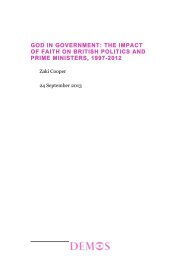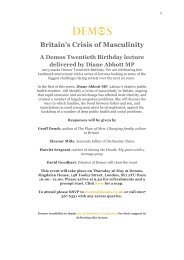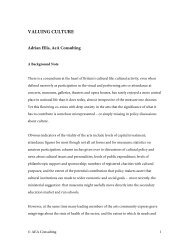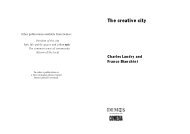Cultural diplomacy - Demos
Cultural diplomacy - Demos
Cultural diplomacy - Demos
You also want an ePaper? Increase the reach of your titles
YUMPU automatically turns print PDFs into web optimized ePapers that Google loves.
<strong>Cultural</strong> Diplomacy<br />
instance, when the V&A redesigned its Islamic galleries, the National<br />
Gallery of Art (NGA) in Washington asked to borrow some of the<br />
collections that were going to go into storage. The V&A obliged<br />
primarily as a matter of public service, but also in the knowledge that<br />
there would likely be opportunities in the future for the NGA to<br />
return the favour. There are a number of projects that involve<br />
multiple partners from different countries. The BL’s International<br />
Dunhuang Project is a ground-breaking international collaboration<br />
to reunify cultural objects that are scattered around the world. This<br />
necessarily involves shared standards of curating, cataloguing,<br />
scholarship, technical issues and so on, but it will also result in<br />
making information and images of more than 100,000 manuscripts,<br />
paintings, textiles and artefacts from Silk Road sites freely available on<br />
the internet. Similarly, the NHM-led SYNTHESYS project involves 11<br />
large collection institutions in creating a shared European<br />
infrastructure for research in natural science. The project is<br />
developing shared resources, common standards and funding access<br />
for scientists from 34 countries. Kew is at the heart of the African<br />
Plants Initiative enabling more than 50 institutions in Africa, Europe<br />
and the US to capture and share data for research and educational<br />
purposes.<br />
As these examples show, cooperation is inherent to the way the<br />
institutions operate. Much of the NHM’s international work is<br />
collaborative and specimens collected will be shared between the<br />
NHM, collaborators or museums in the country of origin, and<br />
sometimes museums in third countries. This agreed practice supports<br />
a distributed international system of collections, information and<br />
expertise that subsequently involves extensive sharing of collections<br />
and mobility of researchers. Furthermore, this openness is not<br />
reserved for other cultural professionals. Anyone from anywhere can<br />
walk into the NHM and have a specimen they have found identified.<br />
The museum gets tens of thousands of enquiries a year, and, while<br />
being generous with their expertise benefits the NHM itself and<br />
benefits science, it is also a notably open and democratic approach<br />
which is not written down or imposed on them. As one scientist from<br />
42 <strong>Demos</strong>






